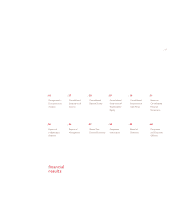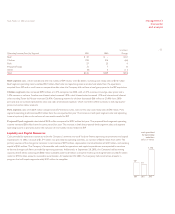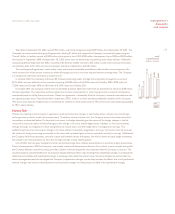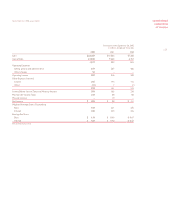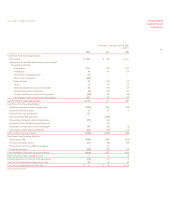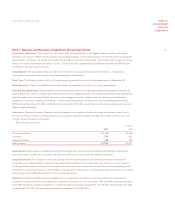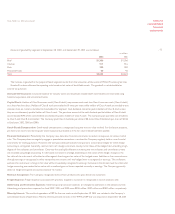Tyson Foods 2002 Annual Report Download - page 28
Download and view the complete annual report
Please find page 28 of the 2002 Tyson Foods annual report below. You can navigate through the pages in the report by either clicking on the pages listed below, or by using the keyword search tool below to find specific information within the annual report.
management’s
discussion
and analysis
p 26
Financial Instruments The Company uses derivative financial instruments to manage its exposure to various market risks, including
certain livestock, interest rates and grain and feed costs. The Company may hold positions as economic hedges for which hedge
accounting is not applied. See Market Risk.
Contingent Liabilities The Company is subject to lawsuits, investigations and other claims related to wage and hour/labor, cattle
procurement, securities, environmental, product and other matters, and is required to assess the likelihood of any adverse judgments
or outcomes to these matters as well as potential ranges of probable losses. A determination of the amount of reserves required,
if any, for these contingencies are made after considerable analysis of each individual issue. These reserves may change in the future
due to changes in the Company’s assumptions, the effectiveness of strategies, or other factors beyond the Company’s control.
See Note 20 to the Consolidated Financial Statements.
Accrued Self Insurance Insurance expense for casualty claims and employee-related health care benefits are estimated using
historical experience and actuarial estimates. The assumptions used to arrive at periodic expenses are reviewed regularly by
management. However, actual expenses could differ from these estimates and could result in adjustments to be recognized. See
Note 1 to the Consolidated Financial Statements.
Impairment of Long-Lived Assets The Company is required to assess potential impairments to its long-lived assets, which is
primarily property, plant and equipment. If impairment indicators are present, the Company must measure the fair value of the assets
in accordance with SFAS121 to determine if adjustments are to be recorded. See Note 1 to the Consolidated Financial Statements.
Goodwill and Intangible Asset Impairment In assessing the recoverability of the Company’s goodwill and other intangible
assets, management must make assumptions regarding estimated future cash flows and other factors to determine the fair value
of the respective assets. If these estimates and related assumptions change in the future, the Company may be required to record
impairment charges not previously recorded. On September 30, 2001, the Company adopted Statement of Financial Accounting
Standards No. 142, “Goodwill and Other Intangible Assets,” and was required to assess its goodwill for impairment issues upon
adoption, and then at least annually thereafter. See Note 1 to the Consolidated Financial Statements.
Cautionary Statements Relevant to Forward-Looking Information for the Purpose
of “Safe Harbor” Provisions of the Private Securities Litigation Reform Act of 1995
This annual report and other written reports and oral statements made from time to time by the Company and its representatives
contain forward-looking statements, including forward-looking statements made in this report, with respect to their current views and
estimates of future economic circumstances, industry conditions, company performance and financial results. These forward-looking
statements are subject to a number of factors and uncertainties that could cause the Company’s actual results and experiences to
differ materially from the anticipated results and expectations expressed in such forward-looking statements. The Company wishes to
caution readers not to place undue reliance on any forward-looking statements, which speak only as of the date made. Tyson undertakes
no obligation to publicly update any forward-looking statements, whether as a result of new information, future events or otherwise.
Among the factors that may affect the operating results of the Company are the following: (i) fluctuations in the cost and availability
of raw materials, such as live cattle, live swine or feed grain costs; (ii) changes in the availability and relative costs of labor and contract
growers; (iii) operating efficiencies of facilities; (iv) market conditions for finished products, including the supply and pricing of alternative
proteins; (v) effectiveness of advertising and marketing programs; (vi) the ability of the Company to make effective acquisitions and
successfully integrate newly acquired businesses into existing operations; (vii) risks associated with leverage, including cost increases
due to rising interest rates; (viii) risks associated with effectively evaluating derivatives and hedging activities; (ix) changes in regulations
and laws (both domestic and foreign), including changes in accounting standards, environmental laws and occupational, health and
safety laws; (x) issues related to food safety, including costs resulting from product recalls, regulatory compliance and any related
claims or litigation; (xi) adverse results from ongoing litigation; (xii) access to foreign markets together with foreign economic conditions,
including currency fluctuations; and (xiii) the effect of, or changes in, general economic conditions.
Tyson Foods, Inc. 2002 annual report



